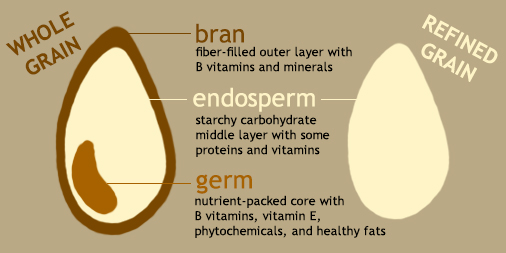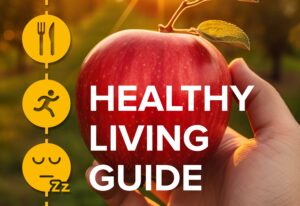

Whole grains offer a “complete package” of health benefits, unlike refined grains, which are stripped of valuable nutrients in the refining process.
All whole grain kernels contain three parts: the bran, germ, and endosperm. Each section houses health-promoting nutrients. The bran is the fiber-rich outer layer that supplies B vitamins, iron, copper, zinc, magnesium, antioxidants, and phytochemicals. Phytochemicals are natural chemical compounds in plants that have been researched for their role in disease prevention. The germ is the core of the seed where growth occurs; it is rich in healthy fats, vitamin E, B vitamins, phytochemicals, and antioxidants. The endosperm is the interior layer that holds carbohydrates, protein, and small amounts of some B vitamins and minerals.
These components have various effects on our bodies:
The invention of industrialized roller mills in the late 19th century changed the way we process grains. Milling strips away the bran and germ and leaves only the soft, easy-to-digest endosperm. Without the fibrous bran, the grain is easier to chew. The germ is removed because of its fat content, which can limit the shelf life of processed wheat products. The resulting highly processed grains are much lower in nutritional quality. Refining wheat creates fluffy flour that makes light, airy breads and pastries, but the process strips away more than half of wheat’s B vitamins, 90 percent of the vitamin E, and virtually all of the fiber. Although some nutrients may be added back by fortification, other health-promoting components of whole grains such as phytochemicals cannot be replaced.
A growing body of research shows that choosing whole grains and other less-processed, higher-quality sources of carbohydrates, and cutting back on refined grains, improves health in many ways. For a closer look at carbohydrates, check out our Carbohydrate Guide.
The 2015-2020 Dietary Guidelines for Americans recommends eating 6 ounces of grain foods daily (based on a 2000-calorie diet) and getting at least half or 3 ounces of that grain intake from 100% whole grains. [1] However, due to an increasing amount of research showing the various health benefits derived from whole grains, and even a possible detrimental effect when eating mostly refined grains, it is recommended to choose mostly whole grains instead of refined grains. An easy way to tell if a food product is high in 100% whole grains is to make sure it is listed first or second in the ingredient list. Or better yet, choose unprocessed whole grains:
| Amaranth | Kamut | Spelt |
| Barley | Millet | Teff |
| Brown Rice | Quinoa | Triticale |
| Buckwheat | Rye | Wheat Berries |
| Bulgur | Oats | Wild Rice |
| Corn | Sorghum |
Be careful when choosing foods labeled as whole grains: “Whole grain” doesn’t always mean healthy.
One study revealed that inconsistent food labeling means that foods identified as “whole grain” are not always healthy. [2]
Consumers should steer towards whole grain foods that are high in fiber and that have few ingredients in addition to whole grain. Moreover, eating whole grains in their whole forms—such as brown rice, barley, oats, corn, and rye—are healthy choices because they pack in the nutritional benefits of whole grains without any additional ingredients.
As researchers have begun to look more closely at carbohydrates and health, they are learning that the quality of the carbohydrates you eat is at least as important as the quantity. Most studies, including some from several different Harvard teams, show a connection between whole grains and better health. [3]
Cardiovascular Disease
Eating whole instead of refined grains substantially lowers total cholesterol, low-density lipoprotein (LDL, or bad) cholesterol, triglycerides, and insulin levels.
Type 2 Diabetes
Replacing refined grains with whole grains and eating at least 2 servings of whole grains daily may help to reduce type 2 diabetes risk. The fiber, nutrients, and phytochemicals in whole grains may improve insulin sensitivity and glucose metabolism and slow the absorption of food, preventing blood sugar spikes. [8] In contrast, refined grains tend to have a high glycemic index and glycemic load with less fiber and nutrients.
Cancer
The data on cancer are mixed, with some studies showing a protective effect of whole grains and others showing none. [12,13]
Digestive Health
By keeping the stool soft and bulky, the fiber in whole grains helps prevent constipation, a common, costly, and aggravating problem. It also helps prevent diverticular disease (diverticulosis) by decreasing pressure in the intestines. [17]
Some grains contain the naturally-occurring protein, gluten. While gluten can cause side effects in certain individuals, such as those with celiac disease, most people can and have eaten gluten most of their lives—without any adverse reaction. However, negative media attention on wheat and gluten has caused some people to doubt its place in a healthful diet, though there is little published research to support such claims. For further information on gluten and health, see: Gluten: A Benefit or Harm to the Body?
The contents of this website are for educational purposes and are not intended to offer personal medical advice. You should seek the advice of your physician or other qualified health provider with any questions you may have regarding a medical condition. Never disregard professional medical advice or delay in seeking it because of something you have read on this website. The Nutrition Source does not recommend or endorse any products.
Discover delicious whole grains and some techniques to prepare them. See the recipes.
Is gluten a benefit or harm to the body? The quick answer is that it can be either, but it all depends on the individual.
Use healthy oils (like olive and canola oil) for cooking, on salad, and at the table. Limit butter. Avoid trans fat.
Drink water, tea, or coffee (with little or no sugar). Limit milk/dairy (1-2 servings/day) and juice (1 small glass/day). Avoid sugary drinks.
The more veggies — and the greater the variety — the better. Potatoes and French fries don’t count.
Eat plenty of fruits of all colors
Choose fish, poultry, beans, and nuts; limit red meat and cheese; avoid bacon, cold cuts, and other processed meats.
Eat a variety of whole grains (like whole-wheat bread, whole-grain pasta, and brown rice). Limit refined grains (like white rice and white bread).
Incorporate physical activity into your daily routine.
Thank you for supporting our mission of translating food and nutrition knowledge into daily practice!
Make a gift
A monthly update filled with nutrition news and tips from Harvard experts—all designed to help you eat healthier. Sign up here.

Explore the downloadable guide with tips and strategies for healthy eating and healthy living.